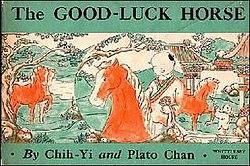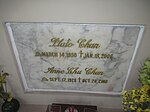 First edition | |
| Author | Chih-Yi |
|---|---|
| Illustrator | Plato Chan |
| Cover artist | Chan |
| Country | United States |
| Language | English |
| Genre | Children's picture book |
| Publisher | Whittlesey House |
Publication date | 1943 |
The Good-Luck Horse is a children's picture book illustrated by Plato Chan, adapted from a folk tale by his mother Chih-yi Chan. Plato Chan was the son of a Chinese diplomat and a child prodigy; he was twelve when he illustrated the book. [1] The Good-Luck Horse was published by Whittlesey House in 1943. It was a 1944 Caldecott Medal honoree. [2] [3] This story has adventures of a horse that a boy had made out of paper and then changed into a real horse by a magician. He was named the good-luck horse because his fortunes fell and rose. Plato Chan (March 14, 1930-January 18, 2006) and wife Anne Chu Chan (September 17, 1928-October 28, 2010) are buried at the Family of G.A. Cu Unjieng Mausoleum Manila Chinese Cemetery .

Plot
The Good-Luck Horse is based on a Chinese folk-tale. It tells the story of a paper horse that was created by a kind magician. Since the horse was magical it was able to do anything it was told to do. The horse then became a problem because it was bringing bad luck to its owner until the horse ran away. When a war broke out the horse met another horse and together they were able to end the war, earning him the name of the good-luck horse. [4]
See also
- The old man lost his horse, the original story
References
- ^ https://www.newyorker.com/magazine/1943/10/30/symposium-2 The New Yorker, Oct. 30, 1943, p. 15
- ^ "The Good-Luck Horse". Goodreads. Retrieved 2016-01-25.
- ^ Chan, Chih-Yi and Plato (1943-01-01). THE GOOD- LUCK HORSE. Whittlesey House.
- ^ E.L.B. (Nov 14, 1943). "Review 1 -- no Title". New York Times. p. 2 – via ProQuest.